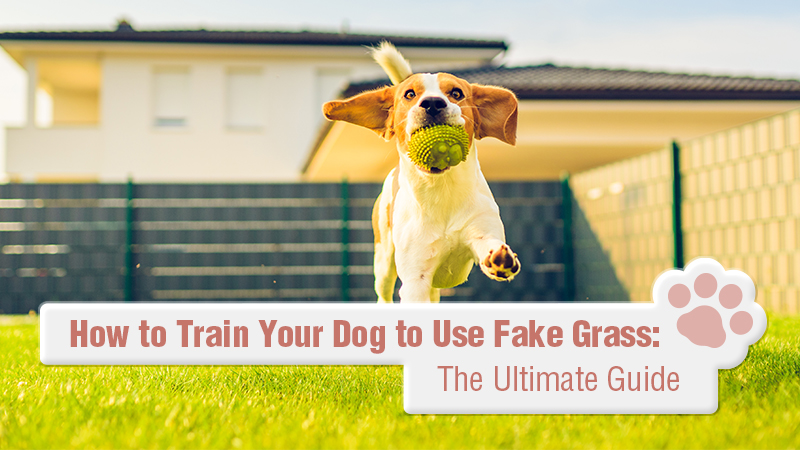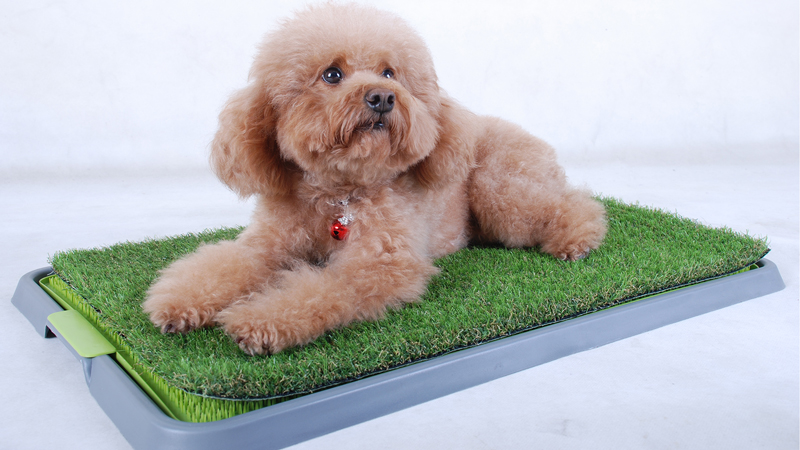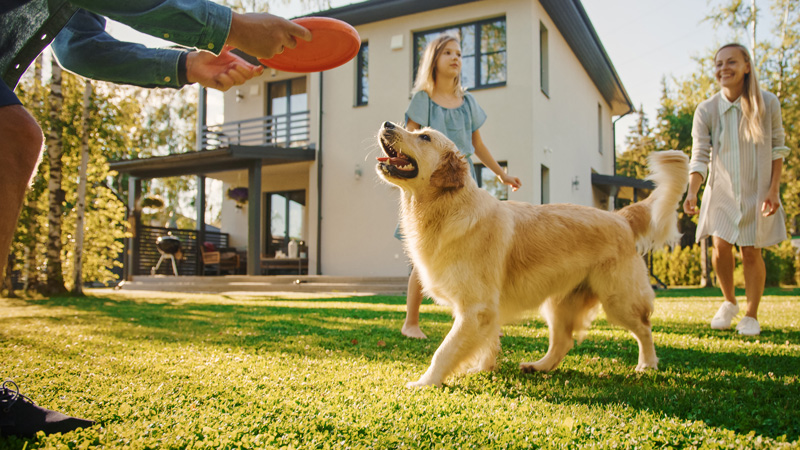How to Train Your Dog to Use Fake Grass: The Ultimate Guide
- 07/17/2025
For dog owners, whether welcoming a new puppy or refining an older dog’s habits, potty training is a crucial step. Establishing a consistent potty routine reduces stress for your dog and keeps floors and furniture accident-free.
Training your dog to use fake grass as a designated potty spot is an ideal solution, especially for busy owners. With the right training, artificial turf provides a clean, low-maintenance area that promotes your dog’s well-being and makes life easier for you, both indoors and outdoors.
In this article:
Why artificial turf is ideal for homes with dogs
Natural look and feel
Today’s artificial grass closely mimics the look and texture of real grass, so your dog will feel comfortable using it. The natural feel of the turf can help pets adapt quickly, providing them with a familiar surface that encourages proper potty habits.
Durability against wear and tear
Pet-friendly artificial grass is made to withstand the wear and tear of daily pet use. Unlike natural grass, which can become patchy or muddy, synthetic turf stays resilient and clean, providing a reliable, long-lasting potty area for your dog.
Resistant to urine damage
Dog urine can cause unsightly, discolored patches on natural grass, gradually turning a green yard dull and muddy as your pet marks its territory. Fake grass is resistant to such damage, maintaining its fresh, green look over time without the risk of discoloration.
Easy maintenance and odor control
Keeping artificial grass for dogs odor-free and hygienic is simple with regular rinsing and occasional use of pet-safe cleaners. Many turf types also come with antimicrobial properties that help control odors, making it a practical choice for busy pet owners.
Versatile for indoor and outdoor use
Synthetic grass works well in both indoor and outdoor settings, offering flexibility to fit various living spaces. Whether you need a designated area in your apartment or a durable spot in your yard, pet turf provides a solution that’s easy to adapt to any environment.
If your dog is hesitant to go outdoors—especially young puppies or those easily stressed—indoor or balcony turf can serve as a gentle transition zone.
For more insights, see our guide on the pros and cons of artificial grass with dogs.
Before you start dog potty training
Choosing the right artificial grass for dog potty
Indoor turf options
Indoor potty turf should be compact, portable, and easy to clean. Opt for a turf pad with a drainage tray, specifically designed for indoor use. Antimicrobial options are ideal for controlling odor in small spaces.
Outdoor turf options
Choose durable, well-draining turf with UV and antimicrobial protection. For a consistent potty area, opt for larger sections. CCGrass Argo Grass is a great option, featuring advanced antibacterial technology, high durability, and superior drainage for a comfortable, odor-free space.
Finding the ideal location
Indoor location
Pick a practical spot for the fake grass potty pad, ideally near a window or balcony to allow airflow and help with odor control. Position it away from busy areas in the home to give your dog a quiet space to focus. The spot should also be convenient for daily access and easy to clean.
Tip: Keep the dog potty away from your dog’s food and water bowls. Dogs naturally prefer to separate their eating and bathroom areas, and this helps maintain hygiene and comfort.
Outdoor location
Choose a designated outdoor spot that’s easy for your dog to reach and separate from play or relaxation zones. Shaded locations keep the turf cooler in hot weather, and proper drainage helps prevent puddles and odor buildup.
Essential training kit for dogs
Leash
Guide your dog to the potty turf with a leash, especially during initial training sessions. This limits movement and keeps them focused on the designated area.
Rewarding treats
Treats are a strong motivator. Reward your dog immediately after they use the artificial turf to create a positive association, making training quicker and more enjoyable.
Comforting toys
If your dog is hesitant, place a favorite toy on the turf to encourage exploration. A familiar item can make the new potty area feel more inviting.
(Optional) Pee Post
A small upright object—like a training pee post or traffic cone—can help male dogs aim and mark more consistently. Many males prefer to urinate against vertical surfaces, so placing one in the middle of the turf may encourage them to use the right spot.
Note: This tool works best for male dogs that already show marking behaviour. It may not be effective for puppies or female dogs.
Steps to train your dog to use artificial grass or grass pads
Whether you’re training a puppy or an adult dog, consistency and encouragement are essential to help them get comfortable using fake grass as their potty area. Here’s a straightforward guide to get started.
Step 1: Introducing your dog to artificial turf
First encounter
When your dog is introduced to the artificial grass for the first time, use a leash to gently guide them onto the edge of the turf. Allow your dog to sniff and explore the area at their own pace, getting used to the new scent and texture.
Positive reinforcement
When your dog steps onto the turf, immediately offer praise and a reward, like a treat, gentle petting, or verbal encouragement. Repeating this process helps create a positive association, so they begin to connect “stepping on the turf = getting rewarded.”
Encourage short stays
Some dogs may step on and step off quickly—that’s normal.
If they seem uneasy or try to leave, don’t force them. Instead, speak calmly and guide them back, rewarding them each time they stay a little longer. Over time, this builds a positive emotional connection with the potty area.
Step 2: Set a consistent routine
Establish potty times
Observe your dog’s natural potty schedule, like after meals, naps, and playtime. Bring them to the artificial grass lawn at these times and let them move around within the area. This consistency helps them recognize the turf as their designated potty spot.
Use verbal cues
Choose a short, clear command like “go potty” and use it consistently each time you bring your dog to the grass potty area.
Over time, your dog will associate the phrase with going to the bathroom on the turf, making the process easier and more predictable.
Step 3: Reward success immediately
Praise and treat
As soon as your dog uses the fake grass potty successfully, offer praise and a treat right away.
Rewards need to come within 1–2 seconds to help your dog make the right connection. Any delay can weaken the learning effect.
Tip: Use a “jackpot treat” (like cheese or steak) specifically for potty success. Saving the best rewards for turf training can significantly speed up results.
Stay consistent
All family members should follow the same training routine and use the same phrase and reward system. Dogs learn through patterns—even small inconsistencies can delay success.
Also, try to keep the artificial grass dog potty in the same spot once you’ve chosen a location.
Step 4: Address mistakes without punishment
Calm redirection
If your dog goes in the wrong spot, don’t scold them.
Punishment can erode their sense of safety, leading them to sneak off and potty in hidden places. Just clean thoroughly and guide them back next time.
Patience is key
Training your dog to use artificial turf may take time, especially if they’re used to another potty routine, like natural grass. Stay patient during the transition, provide positive reinforcement, and stick to the routine for the best results.
Troubleshooting: When your dog still won’t go
Some dogs need a little extra help adjusting to artificial grass—especially if they’ve developed strong preferences for other surfaces or routines. Try these strategies when standard training isn’t working:
Use separate spots for peeing and pooping
Many dogs don’t like doing both in the same place. If your dog pees on the turf but refuses to poop, try placing a second turf pad nearby as a separate toilet.
Add familiar scents (sparingly)
Dogs rely heavily on smell to identify potty areas. Dab a bit of their urine on the turf or slide a used pee pad underneath. Avoid strong smells—too much scent can overwhelm rather than attract.
Try other dogs’ scent (with caution)
In multi-dog households or pet-friendly areas, the smell of another dog’s urine can stimulate marking behavior. A small amount of scent from a trusted dog may encourage your dog to “join in.” This works best for dogs with strong marking instincts.
Simulate outdoor cues
Some dogs are sensitive to the full outdoor experience—grass, soil, even leaves.
Rub a bit of dirt or grass from their usual potty spot onto the turf, and try leaving a few leaves or natural debris on top. The added texture and scent may help your dog recognize the area as “real enough” to use.
Encourage sniffing with treats
Scatter a few pieces of kibble in a small trail around and onto the turf. This mimics a dog’s natural sniffing and circling behavior before going potty. As your dog follows the trail, they may relax and become more willing to use the area.
How to clean your artificial grass after potty training
One of the greatest advantages of using artificial grass for potty training is the ease of cleaning. Keeping the turf clean not only helps maintain a hygienic environment but also ensures that your dog continues to use the area without reluctance.
Cleaning solid waste
When dealing with solid waste, allow it to dry before picking it up to avoid any mess. Use a scoop or gloves for a quick and sanitary clean-up.
Cleaning dog urine
For dog urine, rinse the area with water to dilute and prevent odors. If dog pee has been on the turf for an extended period, use a mild soap and water solution for a deeper clean, ensuring to rinse thoroughly afterward to remove any soap residue.
You can also leave a small trace of scent from previous use to help your dog recognize the area as their designated potty spot.
Unlock stress-free potty training with fake grass
Potty training your dog may take patience, but it’s a rewarding journey that strengthens your bond. With an artificial grass solution, you’ll enjoy easier clean-up and a reliable potty area for your dog. Contact us today to explore our high-quality turf options and make potty training a breeze!
Potty training is a process that takes time, consistency, and patience. By understanding your dog’s natural behaviours—like their preference for soft textures, their use of scent for communication, and their need for a secure potty spot—you can guide them toward success with artificial turf.
Explore our high-quality dog turf options designed for comfort, hygiene, and easy maintenance, and make potty training a smoother experience for both you and your pet.







